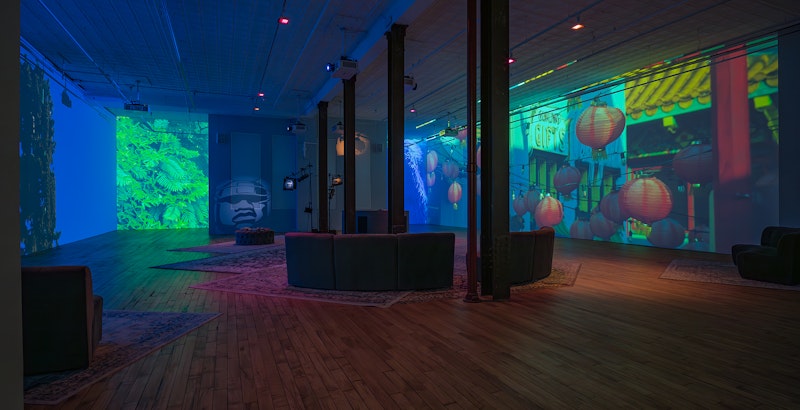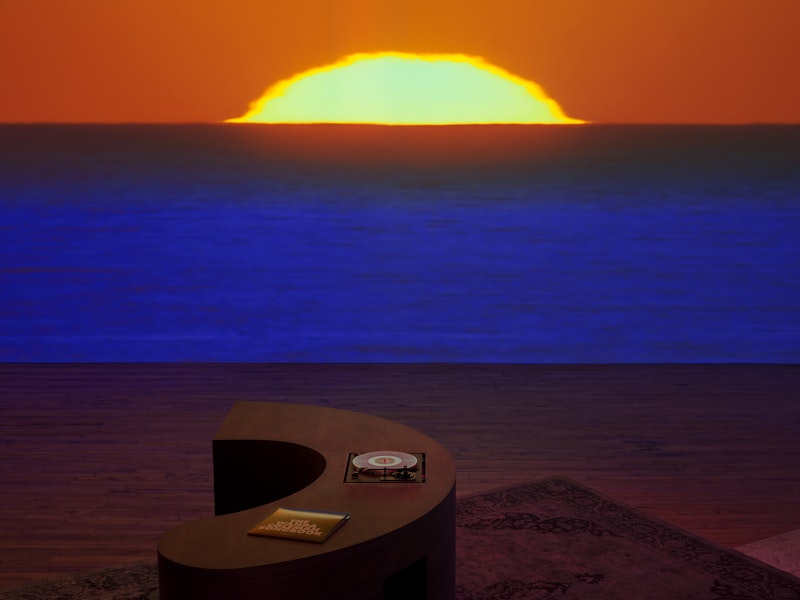
- Source: THE BROOKLYN RAIL
- Author: Charles Moore
- Date: MARCH 7, 2024
- Format: DIGITAL
Cauleen Smith: The Wanda Coleman Songbook

Installation view: Cauleen Smith: The Wanda Coleman Songbook, 52 Walker, New York, January 19–March 16, 2024. Courtesy 52 Walker, New York.
Artist and filmmaker Cauleen Smith (b. 1967) has expertly crafted a love letter to California—and delivered it straight to New York. 52 Walker Gallery presents a multisensory experience in The Wanda Coleman Songbook, featuring Smith’s compelling video work and a range of multimedia accompaniments. On view until March 16, 2024, the show blends scent, sight, and sound to explore the depth of renowned poet Wanda Coleman (1946–2013), who was broadly considered the unofficial poet laureate of Los Angeles during her lifetime.
The Wanda Coleman Songbook honors Smith’s conflicting sentiments around her move back to Los Angeles, following a sixteen-year absence during which she lived in Texas and Chicago. Tasked with rebuilding a life in the city she once knew, she turned to poetry, embracing the works of LA artists including Douglas Kearney, Harryette Mullen, and Wanda Coleman. More than anyone else, Coleman appeared to address Smith directly, through poems she compares to “tender pus-filled wounds, cauterized lacerations, and blue-purple bruises.” The recognition of combined curiosity and terror—and humor—pushed Smith to address Coleman in turn: to amplify the poet’s thoughts on the challenges of Black female vulnerability, especially in a world that discourages any display of weakness. Coleman, Smith describes, highlights the value of finding respite—of seeking levity—even in our darkest moments. The poet achieves this in a manner that’s free from sentimentality or apology, instead speaking bluntly and precisely about her rage. Born in the Watts neighborhood of Los Angeles, Coleman spent much of her childhood reading books, ultimately penning 20 collections of poetry and prose—focusing extensively on racism, poverty, and what it means to feel like an outcast in an otherwise glamorized world. Known colloquially as the “LA Blueswoman,” she found her voice in the vast sociopolitical landscape of her metropolis, and in initiatives like the Studio Watts Workshop, a community arts organization not far from where she grew up. To celebrate Coleman’s contributions, Smith hand-selected poems to feature alongside her videos; in “Wanda in Worryland,” published in the 1993 African Sleeping Sickness collection, the poet writes:
i get scared sometimes
and have to go look into the closet to see if his clothes are still there
i have been known to imagine a situation and then get involved in it, upset, angry and cry hot tears

CAULEEN SMITH, Still from “The Wanda Coleman Songbook,” 2024. The installation is accompanied by limited edition soundtrack with contributions by Kelsey Lu, Shala Miller, moor mother and Aquiles Navarro, Meshell Ndegeocello, Jeff Parker and Ruby Parker, Alice Smith, and Jamila Woods and Standing on the Corner. | © Cauleen Smith. Courtesy the artist and 52 Walker, New York, N.Y.
Here Coleman’s words are no longer isolated on the page. Smith has veered away from an official soundtrack, instead opting to commission a two-color, vinyl, 12-inch EP of songs from musicians like Kelsey Lu, Shala Miller, Jamila Woods, Standing on the Corner, Jeff Parker, Ruby Parker, and Meshell Ndegeocello—each one interpreting a specific Coleman poem. Translating the poet’s lyrical verse into a modern soundscape, Smith directs viewers to Side A, Track 2 of the exhibition’s EP, all while projecting a video of a young Black woman with a somber yet controlled expression, driving her car through the intermittent concrete and greenery of the city. The gallery resembles a recording studio or a movie set in this way; it’s an exchange of energy, and a record of both Coleman’s and Smith’s experiences navigating Los Angeles.
Smith has created an immersive environment, with four video channels projected floor-to-ceiling. The videos depict Los Angeles in full splendor: vintage cars, garden-style apartments erected in close quarters, a lone raven on an electric line, and the pink cadence of the ocean at dusk. Smith keeps audience comfort in mind: inspired by the lush verdure of Griffith Park, a delicate scent drifts through the space, while thoughtfully located rugs and sofas are available for visitors to lounge on. Meanwhile, sound is a separate object entirely in that audiences can start the accompanying record at any point in the video, releasing the stylus on the album at the time of their choosing. The objective is to fuse the senses when the moment feels right—a personal decision that Smith leaves entirely to the viewers.

Installation view: Cauleen Smith: The Wanda Coleman Songbook, 52 Walker, New York, January 19–March 16, 2024. Courtesy 52 Walker, New York.
“LA is a shy one, a real one, and a terrible beauty,” says Smith. “You have to sit with the banality, the horrors, the wildness of the city until it becomes legible.” And so, the artist has done her part to make the city legible—inviting audiences to experience Los Angeles in the same way she and Coleman have. Multilayered and sensational, The Wanda Coleman Songbook balances comfort and conflict, depicting the discomfort and overwhelming beauty of the area, and of those who call it home. Audiences will embrace the opportunity to be led through the streets of Los Angeles—by Smith, and posthumously by Coleman.

